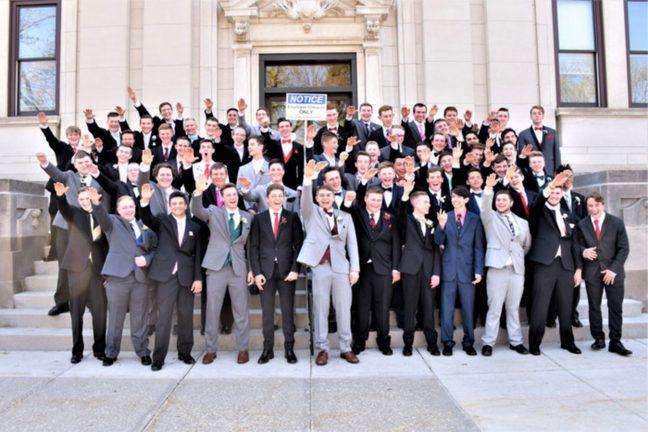When I was 11, I took a trip to the United States Holocaust Memorial Museum in D.C. I saw the shiny black boots of the Nazi SS and their proud, shiny uniforms. In pictures, their arms were outstretched, their faces twisted in wretched admiration for their “führer.” In the next room, an education unlike any other followed. What I saw there has stayed with me for years, pushing me to continue learning about the Holocaust and its impact on our world.
Two weeks ago, I received an essay prompt from my Jewish Studies course. The class was small, but in the last few months, we had tackled an unbelievable amount of material. For a course on the continuing presence of the Holocaust in modern culture, reviewing testimony and written pieces by survivors was — unsurprisingly — emotional, exhausting work.
Wisconsin Poverty Center report serves as painful reminder of Milwaukee’s racial disparities
Overrun by stories of Auschwitz and the haunting recollection of pogroms and mass-shootings, I opened the essay prompt, desperate to pull some meaning out of our class other than the inexplicable, frustrating and bitter taste of the word shoah. Finally, I could begin to synthesize what I had seen in D.C., all those years ago.
“Education is essential to the development of sensitivity to unjust treatment of others,” the prompt said. “Discuss.”
The week after that, a shooting at a synagogue in Pittsburgh shocked the nation. I ducked my head and wrote my paper. Another mass-shooting in California passed us by. “Education is essential,” I said, not truly understanding the gravity of that statement, “but even the best education needs real-world examples to fully convey human suffering and establish true understanding.”
A week after that, I wish I could have taken my words back. Late Sunday night, a photo began circling across Wisconsin social media; in it, a crowd of young, white men in Baraboo stood on the steps of the courthouse, grinning, their arms flung high in a Nazi salute. At the front, a young man made the upside-down “OK” sign, a symbol recently co-opted by far-right trolls and white supremacists online.
UW researcher finds racial segregation increases disparity between black, white homicide rates
Suddenly, a picture that seemed to need no explanation was met by defensive comments. Despite calls for an investigation, parents and community members defended the boys — boys, a deliberate word choice — claiming the salute was made out of ignorance, not malintent. Others called it a foolish mistake, not something the boys’ lives should be ruined over.
I showed the article to my Jewish Studies professor. The expression on her face was heartbreaking; here we were, studying the remnants of the Holocaust in a society that should have known better, only to find ourselves staring into the face of an anti-semitism that was alive — thriving, even — in our country.
UW researcher finds racial segregation increases disparity between black, white homicide rates
Baraboo School District, responding to multiple calls for action in the initial uproar, confirmed that “if the gesture is what it appears to be,” the photo would be addressed. Others suggested the students were merely waving or had been asked by the photographer to make the gesture.
But symbols like the Nazi salute hold immense power, in every context. There are some gestures and signs that are inextricable from hatred and fear; over years of suffering, they have been stained by them. They cannot be sanitized.
If I have learned one thing in this class, it is that the deaths of millions of Jews and other “Untermenschen” cannot be ignored. To say that the Nazi salute was just a “silly gesture” given by boys who didn’t understand the implications implies the gesture can be separated from its source material.
Letter to the Editor: Jews will not be defined by those who wish for their demise
In a world where white supremacists find inspiration from acts of hatred broadcast across television and the internet, addressing the photo from Baraboo half-heartedly is extremely dangerous. When we take acts of anti-Semitism lightly, we aren’t protecting peoples’ futures — we are imperiling them. We normalize white supremacy, in a society where freedom of speech protects those who wish to invoke it. It means we have to police this kind of educational gap ourselves.
If I had the money, I would send those students to D.C. in a heartbeat. Let them breathe in the smell of aged leather boots, abandoned in a railway car. Let them look at the Zyklon B pellets that killed thousands. Let them watch the grainy videotapes of inhumane, gut-wrenching experiments on Jews and Roma, who were less than animals in the hands of Nazi scientists. Let them look at the ovens that burned hundreds to blue-black ash and see if they still think a Nazi salute is innocuous.
There is an extraordinary power imbued in gestures. But the power of education — one that captures all the senses — is infinitely more potent. Never forget, we say. And all I can remember, in the face of events like these, is the enduring smell of leather in a D.C. museum. I cannot forget.
Julia Brunson ([email protected]) is a senior majoring in history.














